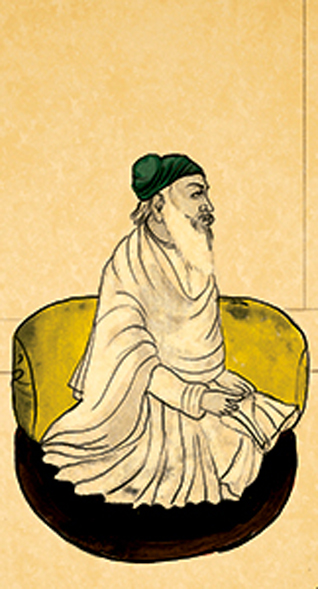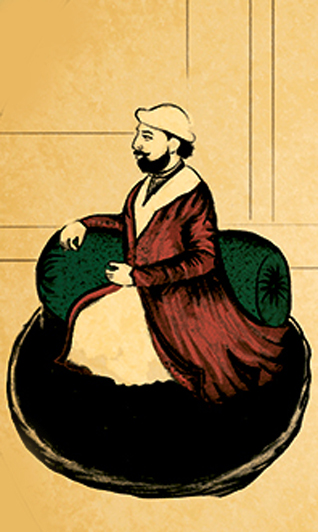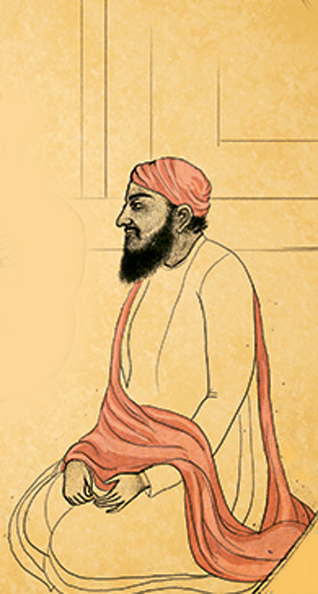Books
The Resourceful Fakirs:
Three Muslim Brothers at the Sikh Court of Lahore
Part I
FAKIR SYED AIJAZUDDIN
THE RESOURCEFUL FAKIRS: THREE MUSLIM BROTHERS AT THE SIKH COURT OF LAHORE, by Fakir Syed Aijazuddin (Three Rivers Publishers, New Delhi, 2014) is sikhchic.com‘s Book of The Month for March 2014.
The following are some excerpts from the book. The author is a lineal descendant of Fakir Nuruddin.
Punjab, the area to which Maharaja Ranjit Singh and Fakir Azizuddin belonged, lay in the northwestern plains of India.
The Punjab derived its name from the five rivers -- Jhelum, Chenab, Ravi, Beas, and Sutlej -- that flowed through its fertile funnel and ultimately merged into the mighty Indus from which India itself took its name.
Geographically, Punjab followed a north-south axis. Rivers that began as streams in its northern mountainous valleys coursed -- sometimes in parallel, sometimes as one -- for more than a thousand miles. They left southern Punjab, crossed Sindh and then ultimately surrendered to the Arabian Sea in the south.
Punjab’s history, though, followed an east-west direction. Every significant event in its often turbulent history, every incursion, every invasion, every permeation emanated from either the west eastwards (the Aryans, the Greeks, the Muslim dynasties, the Mughals) or from the east westwards (the Mauryans, Buddhism, and finally, in a manner of speaking, the British).
The Punjab being the middle ground between empires always belonged to one or the other, never to itself.
Ranjit Singh’s uniqueness was in his giving Punjabiyat a political identity, in welding the Punjabi nation into a sovereign state. His success owed much to the contribution of the three brothers from the Fakir family: Azizuddin, Imamuddin, and Nuruddin.
* * * * *
Throughout his stay as a guest of Ranjit Singh’s, Murray spent more time answering questions about military matters than medical ones. He reported that during his professional visits he was attended only by Fakir Imamuddin. They would see Ranjit Singh usually before the darbar commenced, which was at any time between 9 and 10 am.
On one of these visits, Murray’s observation provides an interesting contrast between Western and Oriental manners.
Murray mentions that, accompanied by Imamuddin, he called on Ranjit Singh and, out of respect, doffed his hat. The turbaned Sikh to whom an uncovered head was a sign of social nakedness told Murray to put his hat back on.
Ranjit Singh used Murray’s presence to impress him with the caliber of his troops. He held parades, had them execute maneuvers, sought his opinion on their uniforms and even on the food they ate.
Where Ranjit Singh fell short of emulating British standards was in the payment of salaries to his troops. His revenues never seemed to equal his expenses and the solution for him lay in delaying payment to his troops. Such a policy was not without hazards.
While Murray was still at the court, there was a mutiny by about 400 of Ranjit Singh’s Golandaze soldiers, whose pay had been in arrears of over nine months. Imamuddin was dispatched to ‘expedite’ the payment. Ranjit Singh knew as clearly as Imamuddin did that payment was possible only if there was money in the treasury. Ranjit Singh promised the mutineers six months’ pay and an amnesty, and for good measure made his second son, Sher Singh, who was popular with the troops, a guarantor. The mutineers trusted the son more than they did the father. No sooner had the rebellious soldiers been brought back into their barracks by Sher Singh than Ranjit Singh had them thrown into prison and as an additional punishment deducted two months’ pay from each sepoy and one month’s from each officer from a salary which in any case he was not paying them.
Murray noted: “This step caused much dissatisfaction, and the sardars employed in bringing the men back to their duty, and who had pledged themselves that the Raja would abide by his word, were very indignant on this occasion.”
Imamuddin must have shared the chagrin of the sardars but any negative feelings he may have harbored were subordinated to fulfilling the Maharaja’s next whim.
* * * * *
Jacquemont knew the position Shahdin’s father and uncles enjoyed at the court. He wrote about them in his journal in a tone akin to awe:
“Among his most intimate councilors are three Mohammadan brothers, who conceal their wealth under an outward appearance of poverty and seek to atone for their intrusion by the humility of their behavior. All of them bear the title of ‘Fakir,’ as do their sons. They know Arabic and have read the medical books in that language, hence their reputation for deep scientific knowledge.
“The eldest, whom I met near Amritsar, is more or less the minister for foreign affairs; it is he who writes all the dispatches from Ranjit to the British government. Another is the trusted agent at Govindgarh. The third, whom I meet every day, is sometimes appointed governor of the city, when Ranjit does not take him away with him. These brothers have a cipher which they use in correspondence among themselves and this artifice, hitherto, I believe, unknown in the East, gives them a reputation for great cleverness.”
* * * * *
Hugel could never get up early enough for Azizuddin. When Azizuddin called on him on the morning of the 14th, Hugel was still fast asleep. Azizuddin, who had been waiting half an hour already, continued waiting until Hugel had dressed himself.
They went into an antechamber where Azizuddin broached the subject of his visit.
“The Fakir assured me, first, that the Maharaja had never conversed with any person whose talent had caused him so much surprise, and he wished I would consent to remain with him,” wrote Hugel.
Touched but not persuaded by such flattery, Hugel replied that had he been a younger man, he might have accepted his host’s offer, but if he missed his boat at Bombay, he would lose a year of his life.
“The Fakir strove to persuade me to remain, but finding me resolute, ceased to importune me further, and said he would take my answer to the Maharaja.”
Meanwhile, could he ask more questions that the Maharaja had dictated?
The first question: Being such a well-traveled man, what had impressed him most during his travels? Hugel pulled an Azizuddin on him. He described the wonders of the Pyramids, the Taj Mahal, New Holland and Kashmir, the might of the East India Company, and ended with “the kingdom founded by Ranjit Singh, who, like a skillful architect, has formed of so many insignificant, unpromising fragments, one majestic fabric, seemed to me the most wonderful object in the world.”
Azizuddin wrote down Hugel’s answer “with sundry wah, wah! as tokens of his amazement.”
* * * * *
Azizuddin collected Fane and his entourage, this time to attend a celebration of Holi. Fane noted that “in front of each chair were small baskets heaped one above another, full of small, brittle balls filled with red powder, and alongside them large bowls of thick yellow saffron and long gold squirts.”
Ranjit Singh broke the ice by taking a large dish filled with saffron and pouring it on Sir Henry’s bald head. Dhian Singh rubbed the Commander-in-Chief with gold and silver leaf mixed with red powder.
Fane noted that few courtiers aimed their squirts at Ranjit Singh directly. Almost everyone present had come appropriately dressed and prepared for such festivities, everyone except the Afghan ambassador who had arrived recently from Kandahar:
“The poor man was dressed in his best, his beard combed and dyed to a nicety, his feet tucked under him, and his face drilled to a grave, diplomatic cast.”
All too soon, the hurling of dye-filled balls began, causing a reddish dust storm so extensive that “the very face of the earth looked red.”
One of the balls hit the Afghan envoy. Fane recalled a scene he would never forget: “His look of astonishment of a ball of red dust being shied in his eye, and his horror when his beard was turned to a bright saffron color.”
Vulnerable and unarmed, the Afghan ambassador took to his heels.
* * * * *
Once inside the tent, Azizuddin placed himself on the chair next to Ranjit Singh. As each sardar was called and stepped forward, Azizuddin provided a brief introduction. Jamadar Khushal Singh was “a close associate … a wise person, brave and courageous.”
Next, Sardar Attar Singh Sandhanwalia: “A close relation of the Maharaja and a brave and courageous man.”
After him, Raja Gulab Singh: “An administrator of civil and military affairs and a brave man.”
Sardar Lehna Singh Sandhanwalia: “A principal sardar and an associate … well versed in administration.”
Ranjit Singh then took the hand of Sardar Nihal Singh Ahluwalia and said that he was the senior most of his clan. “Then Jawad Singh Mokal came there. Fakir-ji said he was a confirmed drunkard [and] lucky go-fellow.”
* * * * *
By 1838, the three Fakir brothers had achieved an almost unassailable position in the Sikh court. Fakir Maudlin -- the first to be used by Ranjit Singh to negotiate with the British on his behalf -- may have found it difficult to perform the role of a diplomat.
He was replaced by Azizuddin and relegated to the post of Keeper of Govindgarh Fort, where he remained until his death. The fort functioned as Ranjit Singh’s treasury (where his bullion was kept) and as his armory (where his weapons and ammunition were manufactured and stored), and so to that extent, Imamuddin’s position could not be written off as a sinecure, nor the fort as a grace-and-favor apartment allocated by a grateful sovereign.
The Killahdari of Govindgarh Fort affirmed the Maharaja’s confidence and trust in him underwritten by Imamuddin’s two brothers -- Nuruddin and Azizuddin.
Over the years, Nuruddin had started functioning for the Maharaja much as a court chamberlain, responsible for ensuring that the paraphernalia that supported the show of royal pomp and pageantry was in the right place at the right time on the right occasion.
When guests arrived, they had to be received with the proper amount of zeafut and appropriate level of hospitality. If transport was required by them, elephants and horses had to be caparisoned, harnessed, and readied. If a darbar had to be held in their honor, the pashmina tents had to be installed and costly carpets aired and rolled out; the presents given and those received in exchange had to be accounted for; and after their departure -- however many guests there may have been and however long they may have stayed -- a report had to be given to the Maharaja who calculated the costs and, against it, mentally evaluated the benefits.
To Nuruddin, over time, arranging such events became second nature. His true achievement, though, lay in being able to succeed in every assignment the Maharaja threw his way and in bringing a degree of order and functionality to a court which enjoyed rituals but abhorred the regimen and effort that made them possible.
For Azizuddin, 1838 would be the year in which his talents as a dignified diplomat, a persuasive negotiator, a skilled draftsman, and an articulate spokesman for the Maharaja would be exploited to their maximum.
The dependence of the Maharaja on Azizuddin had become absolute; his instructions to the delegation he sent to Simla in April 1838 were one instance of this.
Azizuddin moved closer to the Maharaja physically (because the speech impediment following the Maharaja’s stroke made his words unclear except to one who knew his mind as intimately as Azizuddin did) and metaphorically (because Azizuddin was never at a loss for ideas or for words or for that choice mellifluous phrase that could provide color to meaning).
* * * * *
Continued tomorrow …
March 8, 2014
Conversation about this article
1: R Singh (Surrey, British Columbia, Canada), March 09, 2014, 1:27 AM.
The Sikh Raj would have never existed if not for the support of the Muslim population of Punjab.
2: Sunny Grewal (Abbotsford, British Columbia, Canada), March 10, 2014, 10:58 AM.
@1 R Singh ji: Punjab had been divided into sub-units known as Misls. These Misls existed with the support of Sikh military power and not the support of Muslim locals. It was on the foundation of the Misl states that the Sikh Raj existed.





